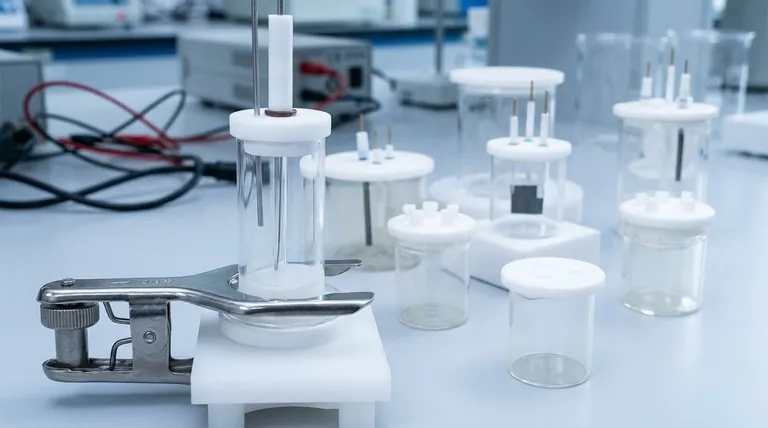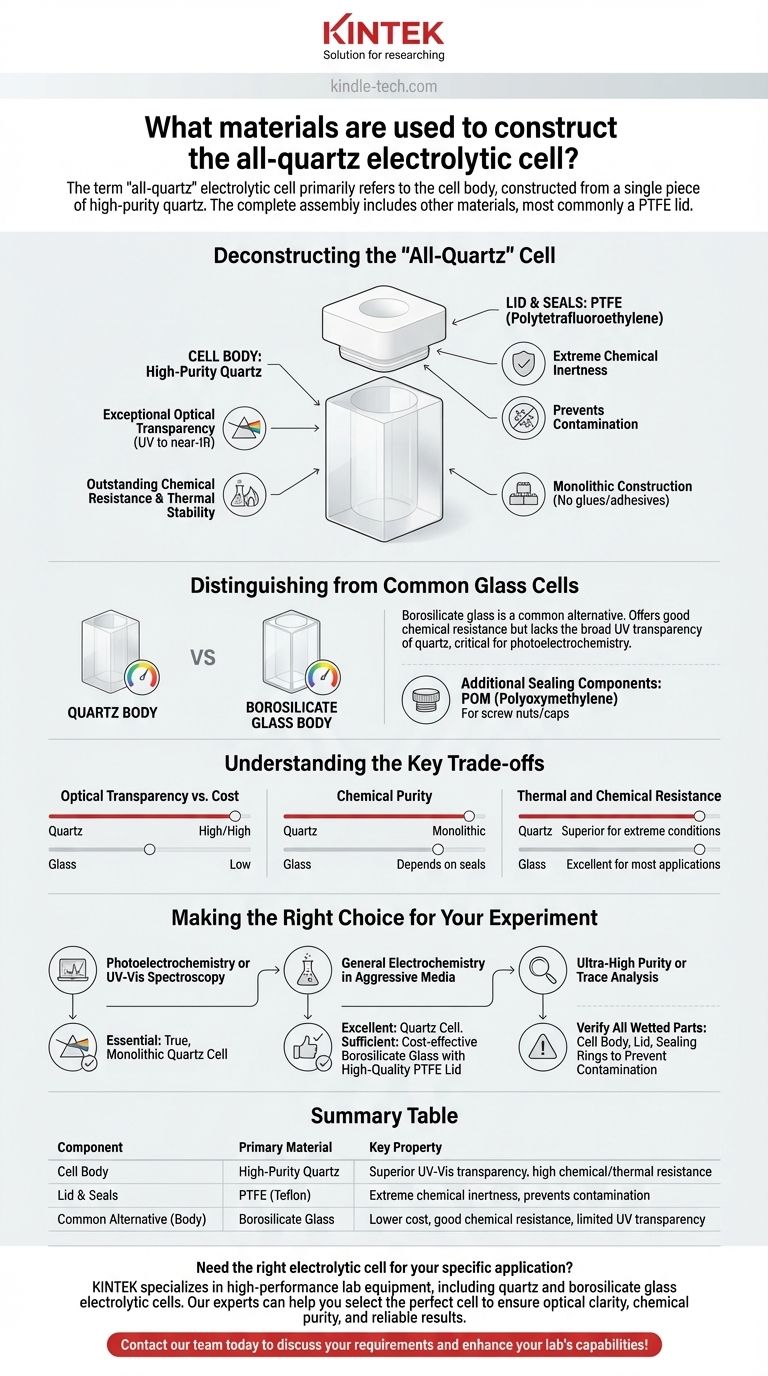The term "all-quartz" electrolytic cell primarily refers to the cell body, which is constructed from a single piece of high-purity, polished quartz. However, the complete assembly includes other materials, with the lid most commonly made from chemically resistant Polytetrafluoroethylene (PTFE).
The name "all-quartz" is a slight misnomer. While the optically and chemically critical body is made of quartz, a complete understanding requires knowing the materials of the lid and seals, which are typically high-performance polymers chosen for their inertness.

Deconstructing the "All-Quartz" Cell
An electrolytic cell's material composition is critical as it directly impacts chemical compatibility, optical transparency, and the potential for sample contamination. Understanding each component's role is key to selecting the right tool for your experiment.
The Cell Body: High-Purity Quartz
The defining feature of this cell is its body, which is machined from a monolithic block of quartz. This construction method avoids the use of glues or adhesives that could leach into the electrolyte.
Quartz is chosen for its superior properties, including exceptional optical transparency from the deep UV to the near-infrared spectrum. It also offers outstanding chemical resistance and thermal stability, far exceeding that of standard glass.
The Lid and Seals: Polytetrafluoroethylene (PTFE)
While the body is quartz, the lid is almost universally made from PTFE (also known by the brand name Teflon).
PTFE is selected for its extreme chemical inertness, making it suitable for use with nearly all solvents, acids, and bases. This ensures that the lid does not react with or contaminate the electrolyte, preserving the integrity of the electrochemical measurement.
Distinguishing from Common Glass Cells
It is important to differentiate an "all-quartz" cell from more common, visually similar alternatives. Many standard electrolytic cells use different materials for the body and sealing components.
Borosilicate Glass Bodies
A frequent alternative to quartz is high borosilicate glass. While also offering good chemical resistance, borosilicate glass does not have the same broad UV transparency as quartz, which is a critical factor for photoelectrochemical experiments.
Additional Sealing Components: POM
In some cell designs, particularly those with threaded caps, other polymers may be present in the external sealing mechanism. Materials like Polyoxymethylene (POM) are sometimes used for screw nuts and caps.
While these parts may not be in direct contact with the electrolyte, it's crucial to verify the material of every component, including any inner seals or o-rings, to ensure compatibility with your system.
Understanding the Key Trade-offs
Choosing between a quartz cell and other options involves balancing performance requirements with practical constraints.
Optical Transparency vs. Cost
The primary advantage of a quartz body is its unparalleled transparency across the UV-Vis spectrum. This is non-negotiable for photoelectrochemistry. However, quartz is significantly more expensive to source and machine than borosilicate glass.
Chemical Purity
A monolithic quartz cell offers the highest level of purity by eliminating adhesives. However, the overall purity of the experiment still depends on the PTFE lid and any other wetted components. For ultra-trace analysis, even high-purity polymers must be considered.
Thermal and Chemical Resistance
Both quartz and borosilicate glass offer excellent thermal and chemical resistance for most applications. Quartz provides an advantage only in the most extreme chemical environments or at very high temperatures where glass might begin to fail or leach ions.
Making the Right Choice for Your Experiment
Your specific experimental goal should dictate your material choice.
- If your primary focus is photoelectrochemistry or UV-Vis spectroscopy: A true, monolithic quartz cell is essential to ensure light transmission to your sample.
- If your primary focus is general electrochemistry in aggressive media: A quartz cell is an excellent choice, but a more cost-effective borosilicate glass cell with a high-quality PTFE lid is often sufficient.
- If your primary focus is ultra-high purity or trace analysis: You must verify the material composition of all wetted parts, including the cell body, lid, and any sealing rings, to prevent contamination.
Ultimately, understanding the complete material profile of your cell is fundamental to achieving reliable and reproducible results.
Summary Table:
| Component | Primary Material | Key Property |
|---|---|---|
| Cell Body | High-Purity Quartz | Superior UV-Vis transparency, high chemical/thermal resistance |
| Lid & Seals | PTFE (Teflon) | Extreme chemical inertness, prevents contamination |
| Common Alternative (Body) | Borosilicate Glass | Lower cost, good chemical resistance, limited UV transparency |
Need the right electrolytic cell for your specific application?
KINTEK specializes in high-performance lab equipment, including quartz and borosilicate glass electrolytic cells. Our experts can help you select the perfect cell to ensure optical clarity, chemical purity, and reliable results for your electrochemistry or photoelectrochemistry work.
Contact our team today to discuss your requirements and enhance your lab's capabilities!
Visual Guide

Related Products
- Quartz Electrolytic Electrochemical Cell for Electrochemical Experiments
- Electrolytic Electrochemical Cell with Five-Port
- PTFE Electrolytic Cell Electrochemical Cell Corrosion-Resistant Sealed and Non-Sealed
- H-Type Double-Layer Optical Electrolytic Electrochemical Cell with Water Bath
- Electrolytic Electrochemical Cell for Coating Evaluation
People Also Ask
- What are the operational procedures and safety precautions during an experiment using an all-quartz electrolytic cell? Ensure Safety and Accuracy in Your Lab
- What are the key features of quartz that make it suitable for electrolytic cells? Discover the 4 Pillars of Superior Performance
- What precautions should be taken when handling and using an all-quartz electrolytic cell? Ensure Safe, Accurate, and Durable Performance
- How should an all-quartz electrolytic cell and its components be maintained for long-term use? A Guide to Maximizing Equipment Lifespan
- What are the available volumes and dimensions for the all-quartz electrolytic cell? Find the Perfect Fit for Your Lab



















